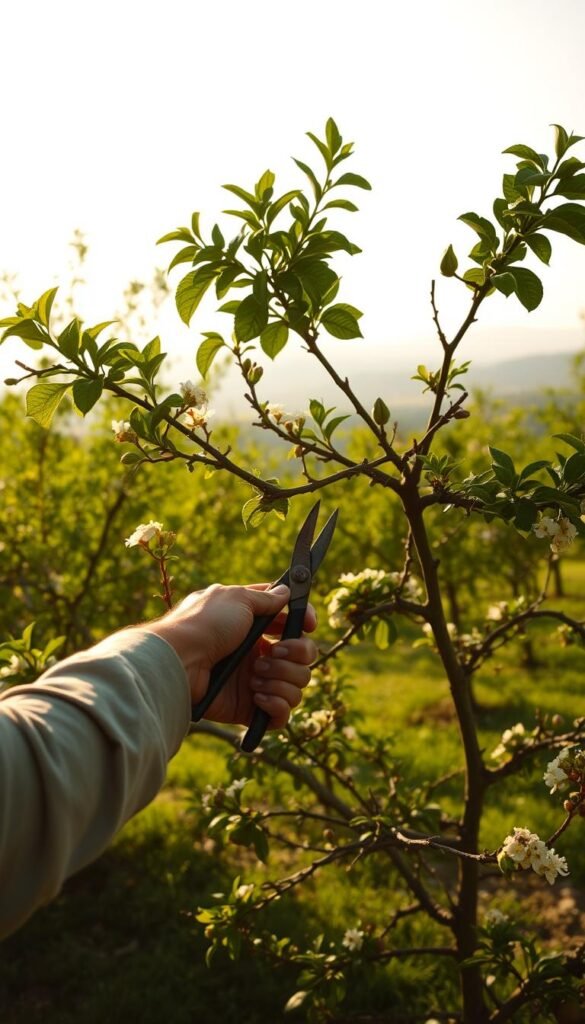Growing thriving plants that bear juicy rewards starts with smart care. While letting nature take its course might sound tempting, untamed branches often lead to disappointing results. Without guidance, these plants focus energy on excessive leafy growth instead of robust, flavorful crops.
Here’s the good news: even basic trimming efforts create noticeable improvements. You’ll notice better airflow through the canopy, which reduces fungal risks. Well-spaced limbs also let sunlight reach developing buds, encouraging sweeter yields. Think of it as giving your plants room to breathe and shine.
New to shaping greenery? Don’t worry. A few strategic cuts each season prevent overcrowding and direct nutrients toward fruit development. Over time, you’ll transform messy thickets into orderly, harvest-friendly shapes. Imagine picking ripe treasures without battling tangled branches!
Healthy maintenance isn’t just about looks—it’s a shield against common threats. Removing deadwood stops infections from spreading, while open structures deter pests. Pair your pruning routine with seasonal checkups, and you’ll enjoy stronger, more resilient specimens year after year.
Understanding the Basics of Fruit Tree Pruning
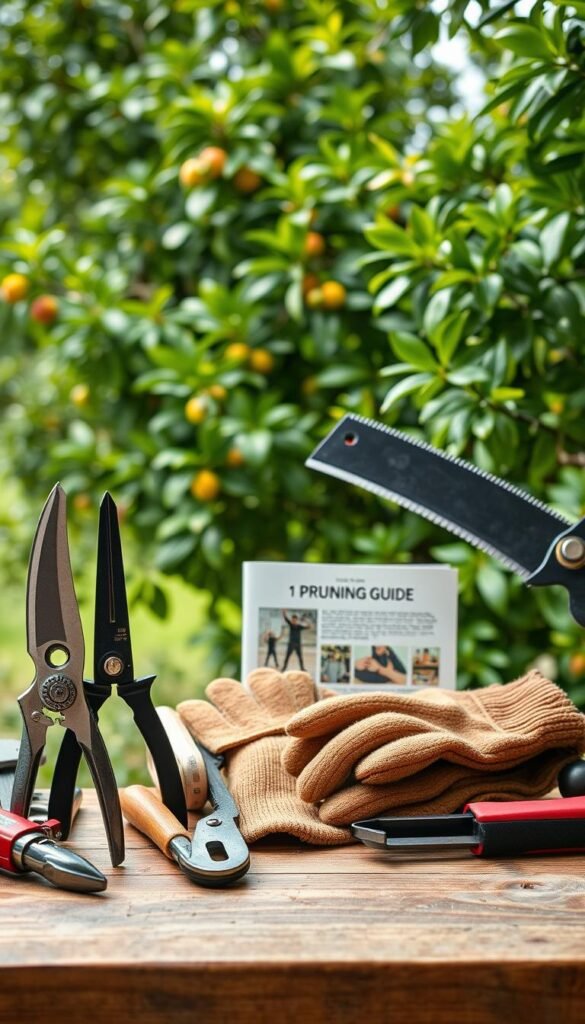
Effective pruning begins with understanding your tree’s natural growth patterns. Think of it as learning a new language – once you grasp key terms and techniques, you’ll communicate better with your plants. This knowledge helps direct energy toward stronger limbs and juicier harvests.
Key Pruning Terms and Techniques
Every cut tells a story. The branch collar – that swollen area where limbs meet – acts as the tree’s healing center. Always slice just outside this zone to help wounds close properly. Two main techniques shape growth:
| Cut Type | Purpose | Result |
|---|---|---|
| Thinning | Remove entire branch | Improves air flow |
| Heading | Shorten branch | Stimulates new shoots |
Look for water sprouts (vertical shoots) and suckers (base growth) – these energy thieves need removal. Flower buds appear plumper than leaf buds, crucial for future crops.
Essential Pruning Tools and Maintenance
Quality tools make clean cuts that heal fast. Hand pruners tackle small branches up to ¾”, while loppers handle thicker ones. For high limbs, pole pruners keep feet safely grounded.
- Disinfect blades with 10% bleach solution between trees
- Sharpen tools monthly during peak season
- Store dry to prevent rust
Remember: dull blades crush tissue, inviting disease. A well-maintained Felco pruner lasts decades, making it worth the investment. Now you’re ready to shape your orchard with confidence!
When and How to Prune Fruit Trees Effectively
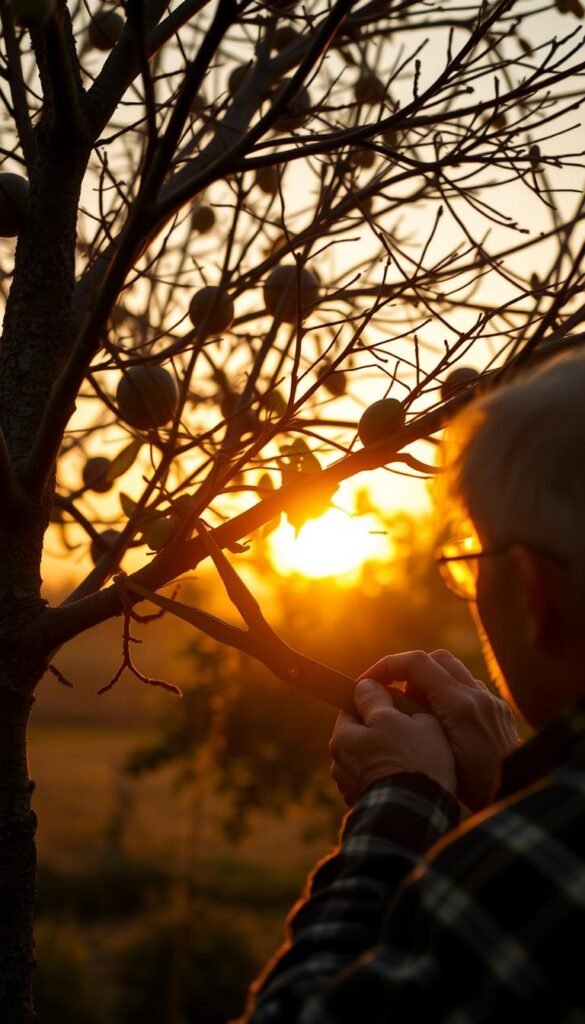
Timing shapes success in shaping your orchard. Deciduous varieties like apples and peaches thrive when trimmed during their sleepy winter phase. This dormancy period lets you make strategic cuts without stressing active growth systems.
Seasonal Pruning Guidelines for Dormant and Active Periods
Late winter reigns supreme for most pruning tasks. In colder zones, aim for February through early March. Desert gardeners should tackle this earlier – January often works best. Wait until after the last frost for citrus varieties.
| Season | Action | Benefit |
|---|---|---|
| Winter | Remove dead branches | Prevents disease spread |
| Spring | Thin crowded areas | Boosts sunlight exposure |
| Summer | Trim water sprouts | Controls size |
Summer cuts focus on maintenance rather than major changes. Remove vertical shoots stealing nutrients from developing fruit. Always sterilize tools between trees to avoid spreading pathogens.
Young Versus Mature Tree Pruning Considerations
Newly planted saplings need bold shaping. Cut them down to 18-24 inches at planting time. This drastic start encourages strong scaffold branches. Established trees prefer lighter annual touch-ups.
For mature specimens, prioritize removing crossing limbs and opening the canopy. Three-step process works best: eliminate deadwood first, then diseased parts, finally address overcrowding. Your strategic snips will pay off in sweeter harvests next season!
Garden with Fruit Trees: Tips for Proper Pruning and Disease Prevention
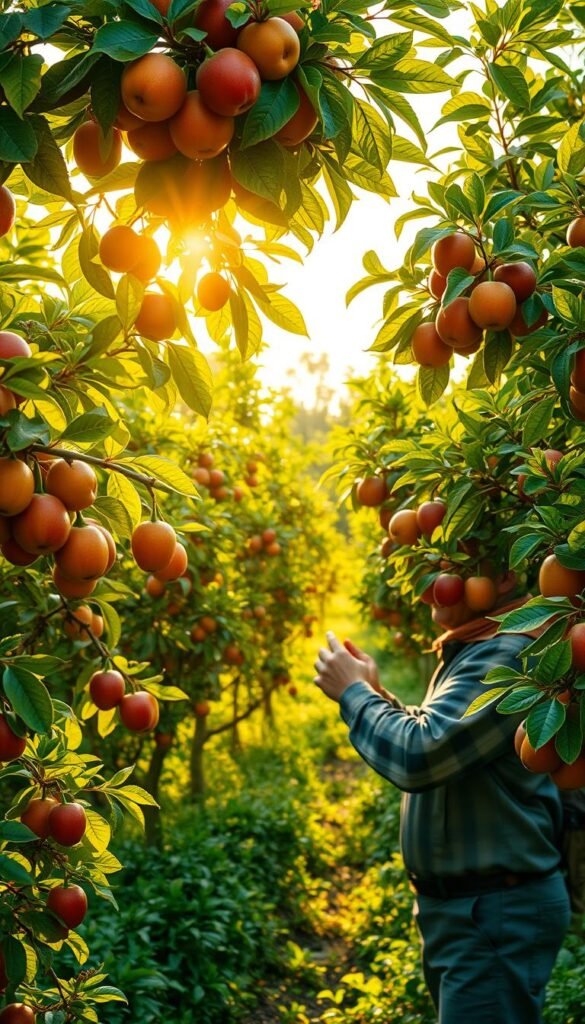
Healthy orchards begin with smart cuts and clean tools. While shaping your plants, you’re also building their defenses. Every snip can either invite trouble or create resilience – let’s make sure it’s the latter.
Strategies for Preventing Disease in Your Trees
Start by removing sick branches immediately. Cut 6 inches below discolored bark to stop infections. Always disinfect blades with a bleach solution after each cut – pathogens hitch rides on dirty tools.
Open canopies are your secret weapon. Space limbs to let sunlight bake damp leaves dry. This simple step slashes fungal risks by up to 40% in humid climates. Thick growth becomes a mold motel – don’t let pests check in!
Methods to Enhance Fruit Production Through Pruning
More light means sweeter rewards. Trim overlapping branches so every bud gets its daily sun bath. Focus on horizontal limbs – they bear the best crops. Vertical shoots? They’re energy vampires stealing nutrients from developing fruit.
For older specimens, try renewal cuts. Remove one-third of aged wood each year to spark new growth. This trick keeps plants productive for decades. Remember: natural healing beats artificial sealants. Skip the wound paint – fresh air works wonders!
Pruning Shapes and Training Methods for Different Fruit Trees
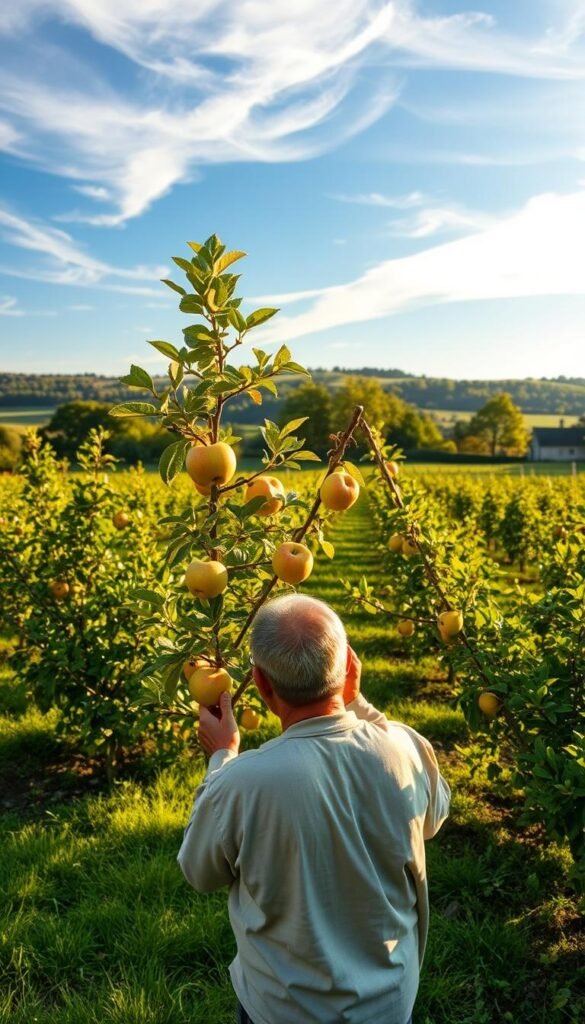
Your orchard’s architecture determines its success. Training young plants into specific forms creates stronger structures and better harvests. Three proven systems help you shape productivity – each tailored to different species’ needs.
Vase, Central Leader, and Modified Leader Techniques
The vase method opens the center like a bowl. Select three to four scaffold branches growing outward at 45-degree angles. This works magic for stone fruits – peaches gulp sunlight, while plums avoid mold in humid air.
| Technique | Structure | Best For |
|---|---|---|
| Vase | Open center | Peaches, plums |
| Central Leader | Single trunk | Apples, pears |
| Modified Leader | Hybrid shape | Cherries, apricots |
Central leader systems build upward strength. Apples thrive with one dominant trunk and evenly spaced limbs. Pears follow suit, their branches forming stair-step layers. Leave 18 inches between tiers for light penetration.
Variety-Specific Pruning Tips for Apples, Peaches, Cherries, and More
Stone fruits demand bold cuts. Remove half of last year’s growth on peaches – they fruit only on new wood. Keep apricot limbs short (under 8 feet) for easy picking.
Apple and pear spurs are gold mines. These knobby twigs produce for a decade if undisturbed. Thin crowded clusters, leaving one fruit every 6 inches. Sweet cherries need gentle shaping – their spurs last 15 years!
- Peaches: Cut back vertical shoots hard
- Apples: Preserve horizontal spur-bearing branches
- Cherries: Minimal annual trimming
Modified leader systems combine the best features. Start with central leader training, then switch to vase shaping once trees reach 7 feet. This hybrid approach gives plums sturdy trunks while maximizing yield.
Year-Round Tree Care and Post-Pruning Strategies
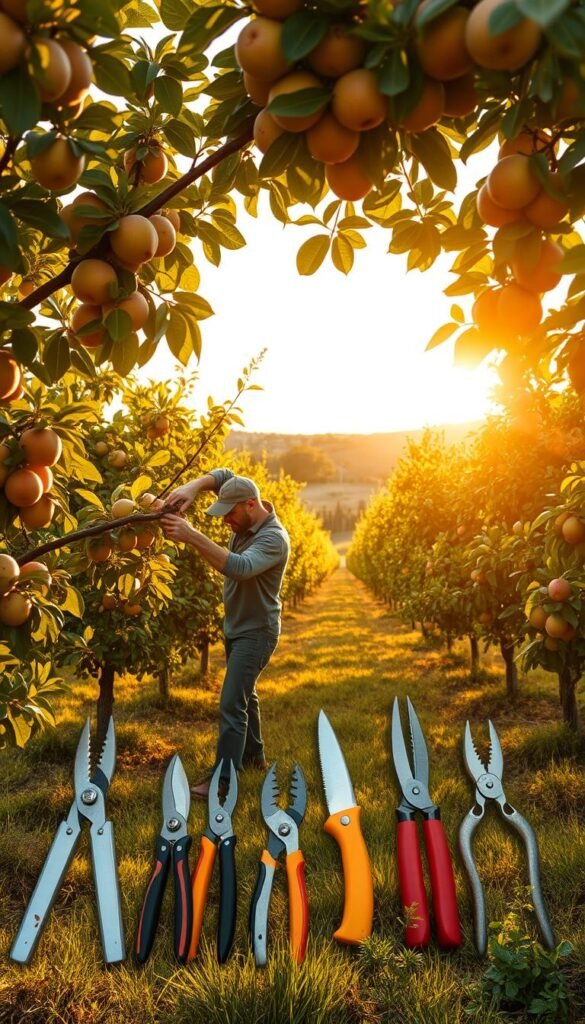
Healthy harvests demand care beyond pruning season. Your trees thrive when supported through consistent maintenance that protects their energy reserves. Let’s explore how simple routines keep plants robust between trimming sessions.
Effective Watering, Mulching, and Wound Care
After pruning, give your plants a deep drink. Soak the root zone until moisture reaches 12 inches deep. This reduces stress and fuels new growth. Wait 3 days before watering again – roots need oxygen too!
Mulch acts like a cozy blanket. Spread 3 inches of wood chips 6 inches from the trunk. This prevents rot while locking in moisture. Renew mulch each spring as older layers break down.
| Season | Care Focus | Key Benefit |
|---|---|---|
| Spring | Sucker removal | Boosts fruit size |
| Summer | Shoot trimming | Prevents overcrowding |
| Fall | Wound checks | Stops infections |
| Winter | Branch audits | Guides next year’s cuts |
Spot vertical shoots? Yank suckers from the base – they’re nutrient thieves. Use thumb and forefinger to snap young ones early. For thicker growth, make clean cuts with sharp pruners.
Thin crowded fruits when they’re marble-sized. Leave one every 6 inches on branches. This simple step creates juicier results by redirecting sugars. Your patience pays off in every bite!
Final Thoughts on Achieving a Productive and Healthy Fruit Garden
Mastering the art of shaping your orchard doesn’t require perfection—just persistence. Every pruning session builds confidence, and even imperfect cuts beat skipping care entirely. Over time, annual shaping transforms wild growth into productive forms that pump out sweeter rewards.
Don’t stress about exact precision. Trees bounce back from errors within seasons, redirecting energy to healthy branches. What matters most? Showing up yearly with clean tools and a willingness to learn. Consistency trumps grand gestures when cultivating robust specimens.
Yes, your plants will survive without attention. But invest time in proper techniques, and you’ll triple harvest sizes while slashing disease risks. Those juicy fruits taste better when grown on well-structured limbs soaking up sunlight.
Remember: This isn’t a one-time project. Think marathon, not sprint. Each season’s minor adjustments compound into decades of abundant production. Start small, stay curious, and let your orchard teach you its language—one careful cut at a time.

